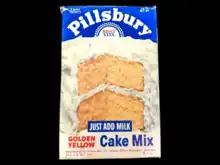Bakery mix
Bakery mix is an add water only pre-mixed baking product consisting of flour, dry milk, shortening, salt, and baking powder (a leavening agent).[1] A bakery mix can be used to make a wide variety of baked goods from pizza dough[2] to dumplings[3] to pretzels. The typical flavor profile of bakery mix differs from that of pancake mix. Bakery mixes do not require refrigeration.[4]

History
Chris Rutt and Charles Underwood of the Pearl Milling Company, developed Aunt Jemima, the first "ready mix." The baking mix was designed for people to just add water to create a mixture that could create pancakes.[5]
Carl Smith, a sales executive at General Mills, got the idea of selling a pre-mixed blend of flour, salt, baking powder, and lard to create biscuits from a chef on a train in 1930. After Smith pitched the idea for a biscuit mix to sell, head chemist of General Mills, Charlie Kress, created Bisquick. Bisquick entered the market in 1931. In the 1940s, Bisquick began using "a world of baking in a box," and printed recipes for other baked goods such as dumplings, muffins, and coffee cake.[6]
In 1933, Pittsburgh molasses company, P. Duff and Sons, patented the first cake mix after blending dehydrated molasses with dehydrated flour, sugar, eggs, and other ingredients.[7] P. Duff and Sons created the cake mix to move surplus molasses, requiring 100 pounds of molasses for every 100 pounds of wheat flour.[8]
After World War Two, flour companies such as General Mills, and Pillsbury, began selling cake mixes due to the surplus of flour. By the 1950s, there were hundreds of cake mix companies.[9] In 1948, Pillsbury introduced the first chocolate cake mix.[10]
Use of Eggs
The Duff company patented a baking mixture requiring fresh eggs in 1935 with writing in the patent application, “The housewife and the purchasing public in general seem to prefer fresh eggs and hence the use of dried or powdered eggs is somewhat of a handicap from a psychological standpoint."[11]
Other companies would continue to use powdered eggs in their bakery mixes, and it's not until sales flattened between 1956 and 1960 that major food companies would revise their formula to incorporate fresh eggs. Ernest Dichter, an analys for General Mills, interviewed women that used the cake mixes and reported that the simplicity of the mixes made women feel too self indulgent because there wasn't enough work involved.[12]
While some say that the difference caused by using fresh eggs was purely psychological, others argued that the inclusion of fresh eggs simply created better products. The cake mix with dried eggs frequently tasted of eggs, stuck to the pan and had poorer texture.[13]
References
- Food Product Design Archived October 25, 2007, at the Wayback Machine
- "Betty Crocker™ Pizza Crust Mix". Betty Crocker. Retrieved 13 October 2022.
- "Original Bisquick Dumplings". recipeland.
- Food Product Design Archived October 25, 2007, at the Wayback Machine
- "Aunt Jemina - Our History". Quaker Oats. Archived from the original on 2007-08-23. Retrieved 13 October 2022.
- Fredrickson, Karen. "The Untold Truth of Bisquick". Mashed. Mashed. Retrieved 13 October 2022.
- Dill, Emma. "Betty Crocker Cake Mix". MNOPEDIA. Retrieved 13 October 2022.
- Park, Michael. "A history of the Cake Mix, the Invention That Redefined 'Baking'". Bon appetit. Retrieved 13 October 2022.
- Greenwood, Veronique. "Why cake mix lacks one essential ingredient". BBC. Retrieved 13 October 2022.
- Firkser, Rebecca. "A history of Boxed Cake Mix". tastingtable. Retrieved 13 October 2022.
- Park, Michael. "A history of the Cake Mix, the Invention That Redefined 'Baking'". Bon appetit. Retrieved 13 October 2022.
- Mikkelson, David. "Requiring an Egg Made Instant Cake Mixes Sell?". Snopes. Snopes. Retrieved 27 October 2022.
- Shapiro, Laura (March 29, 2005). Something from the Oven: Reinventing Dinner in 1950s America. Penguin Books. p. 336. Retrieved 27 October 2022.